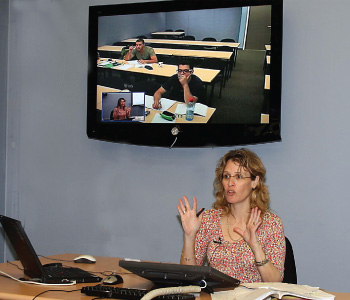Virtual Learning:
Lectures that Don't Evaporate When the Lecturer Finishes
Surveying 17,828 students and lecturers, Open University's Ofek Project analyzed the powerful benefits of its video and broadcast capabilities and presented novel ways for instructors to take advantage of innovative technological advancements.
This past semester, 6,000 Open University students registered to view 130 courses on video. Is video actually a better pedagogic tool than face-to-face learning? Does this signal the end of classroom learning? What other virtual learning techniques can be introduced to enhance learning possibilities? Is video learning equally effective for all types of students?
These and many more questions were examined by the Open University's Shoham Center, The Center for Technology in Distance Education, and the results were both enlightening, and often surprising.
From the Lecturers' Point of View
Almost unanimously, lecturers agreed that courses which offer video conferencing -- there are several formats available -- attract a better quality student, are better organized in terms of time, and offer more effective academic discussions.
Sharon Shafran, senior faculty member of the Department of Management and Economics, plans her lectures for her 100 registered students differently if presenting on video vs. classroom. "Video presentation demands higher standards. My video courses are more organized," she admits.
Moreover, all the lecturers found that because the Ofek courses are material-oriented, in the end you are getting a 'very clean product.' Sharon claims "I managed to teach more in the virtual setting than in the classroom."
One 'challenge' that Sharon and other instructors were met with is the transformation from eye-to-eye contact with the students to a virtual contact. "Even though I know that this is a video, the fact that a few students are sitting in the studio with me, helped to make the experience more real and less virtual." Dr. Efrat Fradkin, senior faculty member in the Department of Literature, Language and the Arts, admits that at first "what bothered me was where are the students?"
However, all the lecturers found that with the advanced technology made available by Shoham's studios, the lack of eye-to-eye contact becomes "irrelevant." In fact, "there was a very nice communication with the students" Dr. Fradkin explained.
To counteract the 'disadvantage' of the physical non-presence of students, interactivity works on a number of levels. Students can chat, write or call in their questions. Pre-prepared pdf's are uploaded to the screen so that students can simultaneously work out problems, or lecturers can use a special digital pen to write down important points as they continue with their lecture. Anat from the Department of Mathematics and
Computer Science, uses a new platform for teaching math. All participants in the class connect simultaneously and a meeting is underway. The students cannot see the lecturer, however similar to the "Illustrator" platform, both students and lecturer can write.
In spite of all the advanced technology, one drawback all admit to is that "there is a delay in terms of question-response" but after a while one becomes acclimated. There is also a sense that less and less students are attending lectures. "I have a feeling" Sharon admits, "that maybe only half the students are attending the regular meetings, and most are not viewing the videos throughout the course of the semester, but rather pack them in at the end of the course in time for the exam." Whether or not this is a disadvantage, however, remains to be seen.
One interesting highlight was that many felt that the videos also make an excellent teaching tool for future instructors.
From the Students Point of View
To learn more about the students who use video conferencing, questionnaires were distributed to 17,828 students who clearly expressed some very definite benefits:
Videos Reinforce Learning: More than half of the students (54%) who came to face-to-face lectures, also used videos to either review materials they had previously not understood or to prepare for exams.
Greater Participation: Those who registered for video conferencing had a higher level of 'seriousness' vis a vis classroom learning: indeed, 85% who registered for video participation participated, yet less than half who registered for classroom participation actually came.
|

